engine CITROEN DS3 2019 Owner's Manual
[x] Cancel search | Manufacturer: CITROEN, Model Year: 2019, Model line: DS3, Model: CITROEN DS3 2019Pages: 233, PDF Size: 6.8 MB
Page 86 of 233
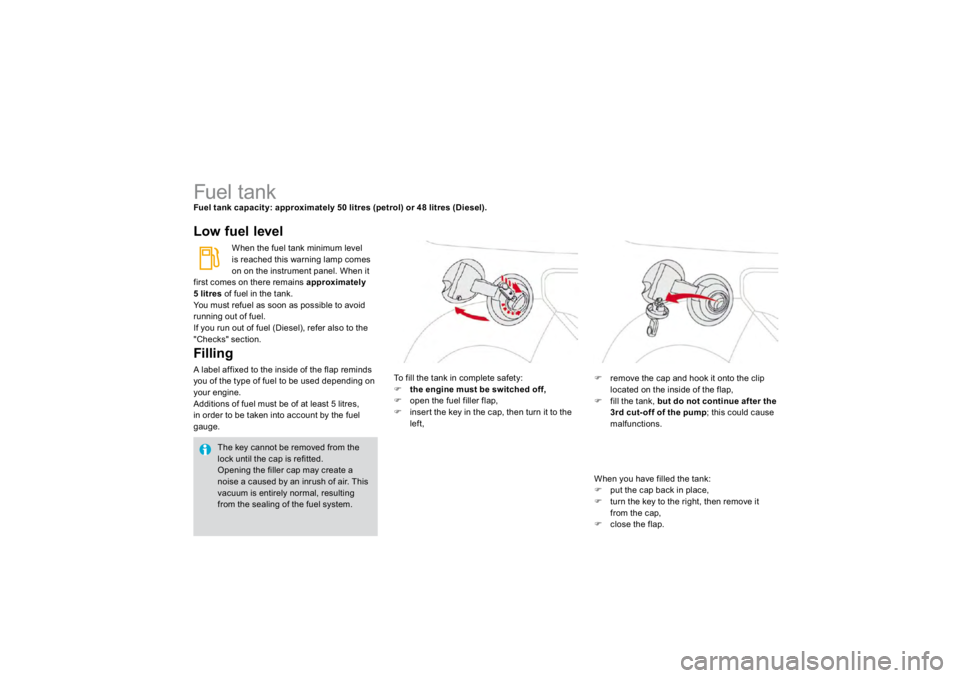
Fuel tank Fuel tank capacity: approximately 50 litres (petrol) or 48 litres (Diesel).Low fuel level Filli
ng
A label affixed to the inside of the flap reminds you of the type of fuel to be used depending on
your engine. Additions of fuel must be of at least 5 litres, in order to be taken into account by the fuelgauge.
The key cannot be removed
from the
lock until the cap is refitted. Opening the filler cap may create a noise a caused by an inrush of air. Thisvacuum is entirely normal, resulting from the sealin
g of the
fuel s
ystem. To fill the tank in complete safety:
�)
the en
gine must be switched o
ff,
�)
o
pen the
fuel
filler
flap,
�) insert t
he key in the cap, t
hen turn
it to t
he
left,
�)
remove the cap and hook it onto the clip
located on the inside of the flap,
�)
fill the tank
, but do not continue a
fter the
3rd cut- o
ff of the
pum
p ; this could cause
ma
lfunctions.
When you have filled the tank:
�)
put the cap back in place,
�)
turn the key to the right, then remove it
from the cap,
�)
close the
flap.
When the fuel tank minimum level is reached this warning lamp comeson on the instrument panel. When it
first comes on th
ere remains approximately
5 litres
of fuel in th
e tank.
You must refuel as soon as possible to avoid
runnin
g out o
f fuel.
I
f you run out o
f fuel
(Diesel
), re
fer also to the
"Checks" section.
Page 87 of 233

93
Access
Quality of the fuel used for petrol engines
The petrol en
gines are per
fectl
y compatible
with E10 type petrol bio
fuels
(containing 10
%
ethanol), conforming to European standards EN 228
and EN
15376.
E85 type fuels (containing up to 85 % ethanol) are reser ved exclusivel
y for vehicles marketed
for the use o
f this t
ype o
f fuel
(BioFlex
vehicles). The quality of the ethanol must compl
y with European standard EN 15293.
For Brazil only, special vehicles are marketed to run on fuels containing up to 100 % ethanol (E100 type).
Qualit
y of the fuel used for
Di
ese
l en
gi
nes
The Diesel engines are per
fectly compatible
with biofuels which conform to current and
future European standards (Diesel fuel which complies with standard EN 5
90 mixed with a
biofuel which complies with standard EN 14214) available at the pumps
(containin
g up to 7 %
Fatty Acid Meth
yl Ester
).
The B
30 bio
fuel can be used in certain Diesel
en
gines;
however, t
his use
is su
bject to str
ict
application o
f the special servicing conditions.
Consult a CITROËN dealer.
The use of any other type of (bio)fuel
(vegetable or animal oils, pure or diluted,
domestic fuel...) is strictl
y prohibited
(risk of
dama
ge to the en
gine and fuel s
ystem
).
Page 99 of 233
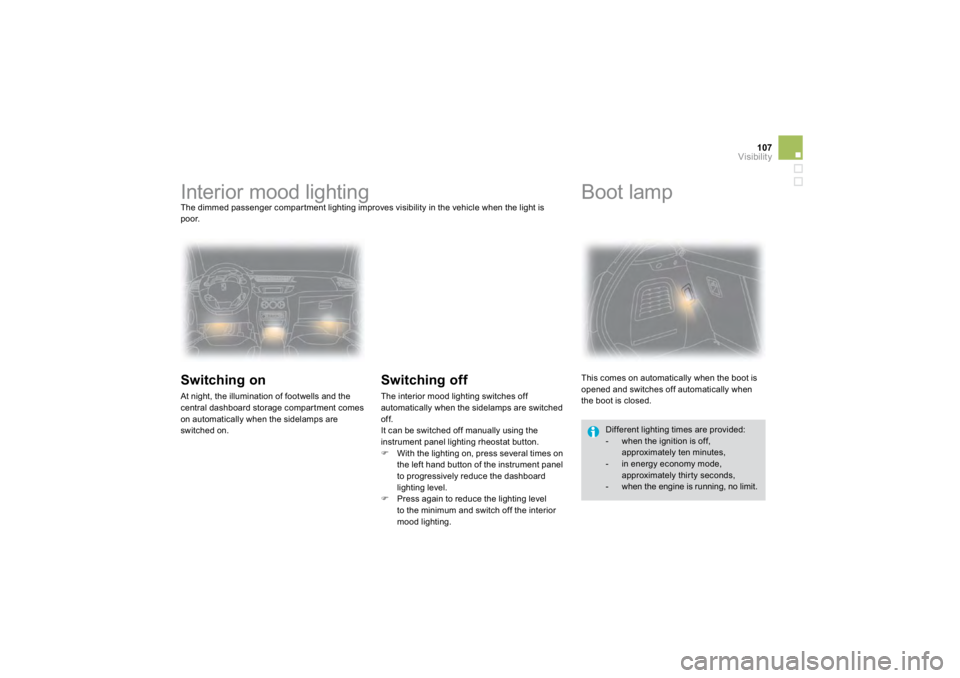
107
Visibility
Interior mood lighting
The dimmed passenger compartment lighting improves visibility in the vehicle when the light is poor.
Switching on
At night, the illumination of footwells and the centra
l dashboar
d stora
ge compartment comes
on automat
ically when t
he s
idelamps are
switched on.
Switchin
g off
The interior mood li
ghtin
g switches of
f
automat
ically when t
he s
idelamps are sw
itched
off.
It can be switched o
ff manuall
y usin
g the
instrument pane
l lighting r
heostat
button.
�)
With the lighting on, press severa
l times on
the left hand button of the instrument panel to progressively reduce the dashboard lighting level.
�)
Press a
gain to reduce the li
ghtin
g level
to the minim
um and switch off the int
erior
mood lighting.
This comes on automatically when the boot is opened and switches off automaticall
y when
t
he boo
t is closed
.
Boot lamp
Different li
ghtin
g times are provided:
- when the i
gnition is o
ff,
approx
imate
ly ten m
inutes,
- in energy economy mode,
approximately thirty seconds,
- when the engine is running, no limit.
Page 116 of 233

131Safety
Emergency braking ass
istance
System which, in an emergency, enables you to o
btain the opt
imum
braking pressure more
quickly, thus reducing the stopping distance.
Activation
It is triggered by the speed at which the brake pedal is presse
d.
The effect of this is a reduction in the resistance of the pedal and an increase in braking efficiency.
When braking in an emergency, press firmly without releasing the pressure.
Trajectory control systems Anti-skid regulation (A
SR)
and e
lectron
ic sta
bili
ty
programme (E
SP)
The anti-skid re
gulation
(also known as
Traction Control
) optimises traction to prevent
skiddin
g of the wheels, b
y actin
g on the brakes
o
f the drivin
g wheels and on the en
gine.
The e
lectron
ic sta
bility pro
gramme acts on t
he
brake o
f one or more wheels and on the engine
to keep the vehicle on the trajectory required by the driver, within the limits of the laws o
f
physics.
Activat
ion
These s
ystems are act
ivate
d automat
ically
each time t
he ve
hicle is starte
d.
They come into operation in the event o
f a grip
or trajectory problem.
This is indicated by flashing of this
warnin
g lamp on the instrument panel.
Page 127 of 233
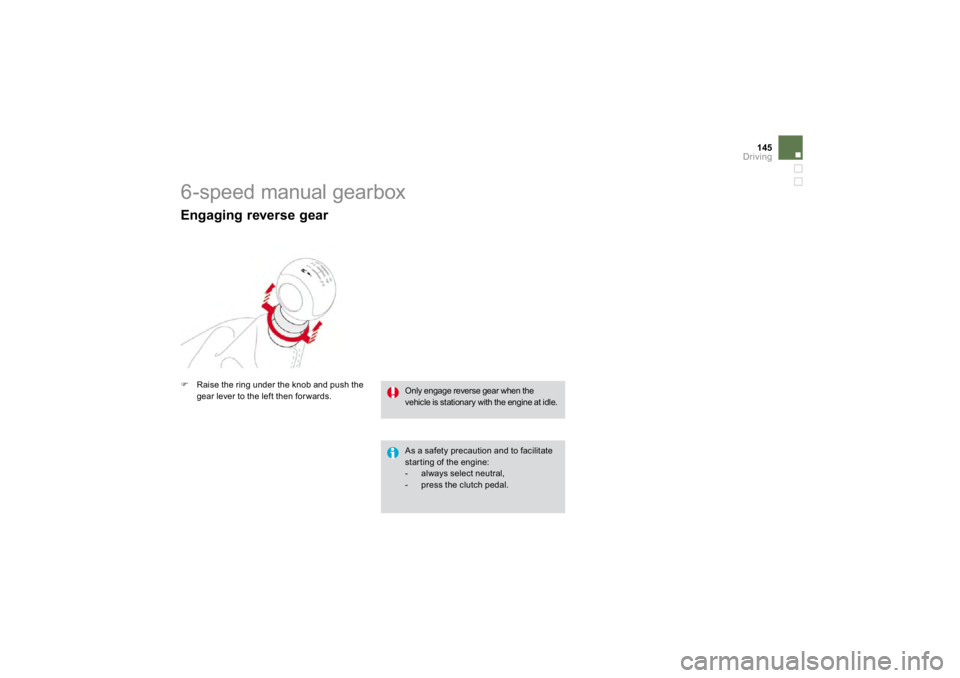
145
Driving
6-speed manual gearbox �)
Raise the ring under the knob and push the gear lever to the left then for wards.
Engaging reverse gear
As a sa
fety precaution and to
facilitate
starting of the engine:- always select neutral, - press the clutch pedal.Only engage reverse gear when the vehicle is stationary with the engine at idle.
Page 128 of 233
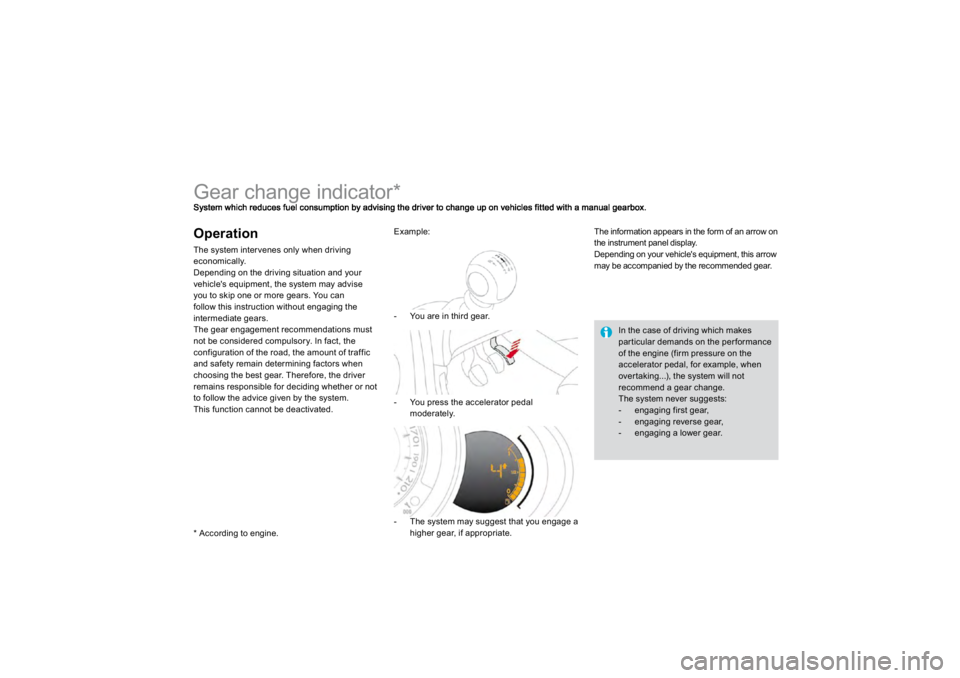
Gear change indicator * OperationThe system inter venes only when drivingeconomically. Dependin
g on the drivin
g situation and
your
vehicle's equ
ipment, t
he s
ystem ma
y advise
you to s
kip one or more
gears.
You can
follow this instruction without engaging the interme
diate gears.
The gear engagement recommendations must not be considered compulsory. In fact, the configuration of the road, the amount of traffic and safety remain determining factors when choosing the best gear. Therefore, the driver remains responsible
for decidin
g whether or not
to follow the advice given by the system. This function cannot be deactivated.
-
The s
ystem ma
y su
ggest t
hat you en
gage a
hi
gher
gear, i
f appropriate. The information appears in the form of an arrow on
the instrument panel display.
Dependin
g on
your vehicle's equipment, this arrow
may be accompanied b
y the recommended
gear.
In the case of drivin
g which makes
particular demands on the
performance
of the en
gine
(firm pressure on the
accelerator
pedal,
for exam
ple, when
over taking...
), the system will not
recommen
d a gear c
hange.
The system never suggests: - engaging first gear, - engaging reverse gear, - en
gaging a lower
gear.
* According to engine.
Example: -
You are
in third gear.
-
You
press t
he acce
lerator
pedal
mo
derate
ly.
Page 129 of 233

147
Driving
Four-speed automatic gearbox which offers a choice between the comfort of fully automaticoperation, enhanced by sport and snow pro
grammes, or manua
l gear c
hanging.
Therefore, four driving modes are offered: -
automatic
operation
for electronic
management of the gears by the gearbox,
-
spor
t programme for a more dynamic style
of driving,
-
snow
programme to improve driving when
traction is poor,
-
manual
operation for sequential changing
of the gears by the driver.
Automatic gearbox
1.
Gear lever.
2.
B
utton "
S"
(sport
).
3. Button "�7"(snow).
Gear selection
gate
P. Park.
- Immobilisation o
f the vehicle, parkin
g brake
on or o
ff.
-
Starting the engine.
R. Reverse.
- Reversing manoeuvres, vehicle stationary, engine at idle.
N. Neutral.
- Immobilisation o
f the vehicle, parkin
g brake on.
-
Startin
g the en
gine.
D.Automat
ic o
perat
ion.
M. +
/- Manua
l operat
ion w
ith se
quent
ial
changing o
f the
four gears.
�)
Push for wards to change up through the gears.
or �) Pull backwards to change down through
the
gears.
Gea
r l
ever
Page 130 of 233
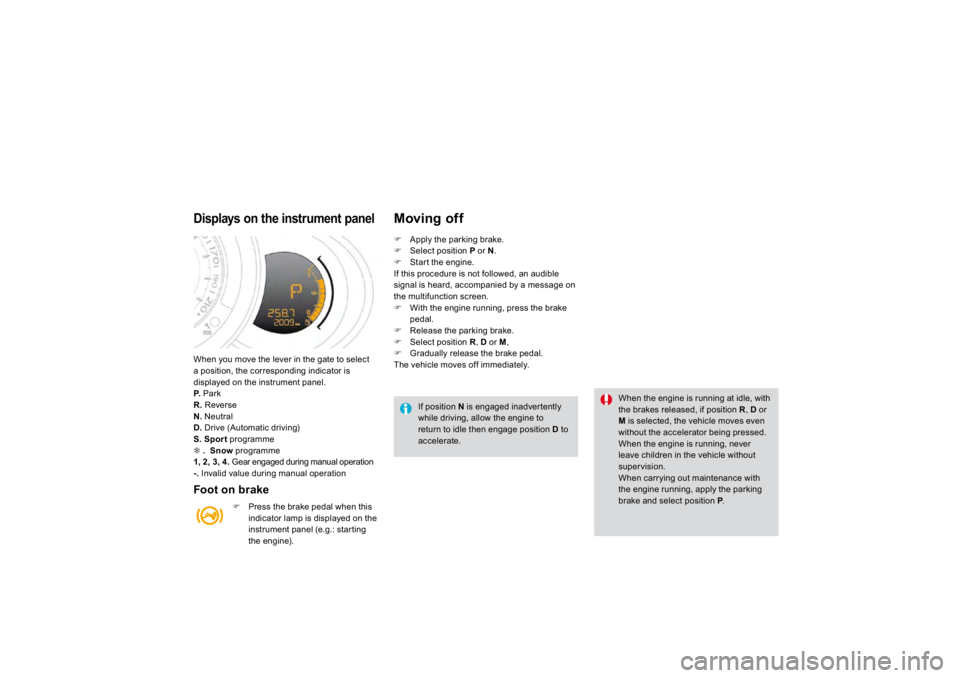
When you move the lever in the gate to select a position, the corresponding indicator is displayed on the instrument panel. P. Park
R.Reverse
N. Neutra
l
D. Drive
(Automatic driving
)
S. Spor
tprogramme
�7.Sno
w
programme
1, 2, 3, 4
.Gear engaged during manual operation
-.Invalid value during manual operation Displays on the instrument panelFoot on brake
�)
Press the brake pedal when this indicator
lamp
is displaye
d on t
he
instrument panel (e.g.: starting the engine).
Movin
g off
If position
Nis en
gaged inadver tent
ly
whil
e driving, a
llow t
he eng
ine to
return to
idle then engage pos
ition
Dto
accelerate.
Wh
en t
he eng
ine
is runn
ing at
idle, w
ith
the brakes released, i
f position
R , D or
M
is selected
, the vehicle moves even
without the accelerator being pressed.
When the engine is running, neve
r
lea
ve children in th
e vehicle with
out
superv
ision.
Wh
en carr
ying out ma
intenance w
ith
the en
gine runn
ing, app
ly the par
king
brake an
d se
lect
position
P. P
�) Apply the par
king
brake.
�)
Select position
P or N.
�)
Start the engine.
If this procedure is not followed, an audible
signal is heard, accompanied by a message on the multifunction screen.
�) With the en
gine runn
ing, press t
he brake
pedal.
�) Release t
he par
king brake.
�) Select position
R , Dor M ,
�) Gradually release the brake pedal.
The vehicle moves off immediately.
Page 131 of 233

149
Driving
Automatic operation�)
Select position
D for automatic
chan
ging
o
f the
four
gears.
The gearbox then operates in auto-adaptive mode, without any inter vention on the part of the driver. It continuously selects the mostsuitable gear according to the style of driving, the profile of the road and the load in thevehicle.
For maximum acceleration without touching
the lever, press the accelerator pedal down fully (kick down). The gearbox changes down automat
ically or ma
inta
ins t
he gear se
lecte
d
unt
il the max
imum en
gine spee
d is reac
hed.
On braking, the gearbox changes down automatically to provide efficient engine braking.
If you release the accelerator sharply, thegearbox will not change to a higher gear for safety reasons.
Never select position
Nwhile the
vehicle is moving.
Never select positions
Por R
unless
the ve
hicle is comp
lete
ly stat
ionar
y.
Sport and snow programmes
These two spec
ial pro
grammes supp
lement t
he
automatic operation in very speci
fic conditions
o
f use.Sport programme "
S"
�)
Press
button "
S", after starting the engine.
The gearbox automatically favours a dynamic
style of driving.
S appears on t
he instrument
pane
l.
Snow pro
gramme "
�7"
�) Press button "
�7", a
fter startin
g the en
gine.
The gear
box a
dapts to
driving on s
lipper
y
roads.
Thi
s programme
improves start
ing an
d drive
when tract
ion
is poor.
�7appears on t
he instrument
pane
l.
Retu
rn
to
auto
m
at
ic
operat
ion
�) At an
y time, press t
he button se
lecte
d
again to qu
it the programme engage
d an
d
return to auto-a
daptive mo
de.
Page 132 of 233

Manual operation
D disappears an
d the gears en
gaged
app
ear
in success
ion on t
he
instrument
pane
l.
In the event of the engine labouring
or over-revving, the gear selected flashes for afew seconds, then the actual gear engaged isdisplayed. It is possible to change from position
D
(automatic) to position
M
(manual) at any time.
Wh
en t
he ve
hicle is stat
ionar
y or mov
ing
very slowly, the gearbox selects gear
M1
automatically. The sport and snow programmes do not operate in manual mode.
Invalid value durin
g manual
operation
�)
Select
position
M for sequent
ialchanging
o
f the
four gears.
�)
Push the lever towar
ds the +
sign to
change up a gear.
�)
Pull th
e lever towards the - sign to change
down a gear.
It is onl
y possible to chan
ge from one
gear to
another i
f the vehicle speed and en
gine speed
permit; other wise, the gearbox will operate temporarily in automatic mode.
This s
ymbol is displa
yed i
f a gear
is not en
gaged correctl
y (selector
between two positions
).
Stoppin
g the vehicle
Before switchin
g off the en
gine,
you can en
gage
position
Por N
to p
lace t
he gear
box in neutra
l.
In both cases, app
ly the par
king
brake to
immo
bilise t
he ve
hicle.
Wh
en t
he ignition is on, t
he
lighting of this warning lamp,
accompanied by an audible
signal and a message on the multifunction screen,
indicates a
gearbox malfunction.
In this case, the
gearbox switches to back-up mode
and is locked in 3rd gear. You ma
y feel a substantial
knock when chan
ging from
Pto R and from R
Nto R.R
This w
ill not cause an
y dama
ge to t
he gear
box.
Do not exceed 60 mph
(10 0 km
/h), local speed
restrictions permitting.
Contact a CITROËN dealer as soon as possible.
Operatin
g fault
If the lever is not in position
P ,P
when the driver's door is opened or approximatel
y 45 seconds after the
ignition is switched o
ff, a messa
ge
app
ears in the multi
function screen.
�)
Return t
he lever to
position
P; the
message
disappears.
There is a risk o
f dama
ge to the
gearbox:
- i
f you press the accelerator and brake pedals at t
he same t
ime,
- i
f you
force the movement o
f the
gear lever from the
Pposition to
another position when the battery is flat.
To reduce fuel consumption when at a prolon
ged standstill with the en
gine
runnin
g (traffic
jam...
), put the
gear
lever in th
e Nposition and appl
y the
parkin
g brake.